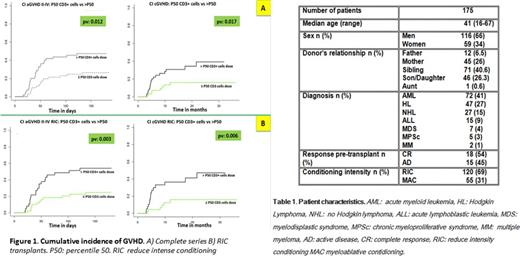Abstract
Introduction:
CD34+ and CD3+ cell dose in peripheral blood stem cell (PBSC) graft have been related with increased incidence of graft versus host disease (GVHD) in some transplant settings. Our aim in this study was to evaluate the impact of CD34+ and CD3+ cells graft composition on GVHD incidence in the setting of haploidentical transplant (haplo-HSCT) with post-transplant cyclophosphamide (PT-Cy), in a multicenter analysis.
Materials (or patients) and methods:
We retrospectively evaluated 175 patients with hematologic malignancies who were treated with a haplo-HSCT from 2011 to 2014 with PBSC in GETH centers. All patients received Busulfan-Fludarabine as conditioning regimen and GVHD prophylaxis was performed with PT-Cy (50 mg/kg on days +3 and +4) and a calcineurin inhibitor plus mycophenolate from day +5. We analyzed the impact of CD34+ and CD3+ cell doses (low vs. high with cut-off at the median value, and the 25-75 percentiles) on the development of acute and chronic graft versus receptor disease. Death before GVHD development was considered as a competitive event. The analysis was adjusted for conditioning intensity. STATA software was used for data analysis
Results:
We analyzed 175 patients. Patient characteristics are resumed in table 1. Median CD34+ and CD3+ cell dose was 5.31x10e6/kg (p 25-75: 4.31-6.1) and 2.07x10e8/kg (p25-75: 1.19-2.94), respectively. Cumulative incidences of grade II-IV acute GVHD and all grades chronic GVHD was 32.6% and 30% respectively. The median follow-up was 12.3 months (r:6-46). No difference in terms of GVHD (acute and chronic), was found between low and high CD34+ cell doses. However, if we focus on T cells, high doses of CD3+, for values above the median, have been has been associated with increased incidence of acute GVHD II-IV (day 150: 47% vs 26% p=0.01, figure 2), as well as cGVHD (30 month: 39% vs 16%, p= 0.01 figure 1). If we focus the analyses regarding the intensity of conditioning regimen, the influence of CD3+ doses remains for the group of reduced-intensity conditioning (RIC) (aGVHD, day 150: 54% vs 24%, p=0.003; cGVHD, 30 month: 47% vs 16%, p=0.006 figure 2), but lost for patients who receive myeloablative intensity (aGVHD, day 150: 33% vs 33% p=0-8; cGVHD, 30 month: 21% vs 16%, p=0.81)
Conclusion:
In our series, in the setting of haplo-HSCT with Pt-Cy, the highest dose of lymphocytes was associated with a higher incidence of aGHVD II-IV and cGV HD, especially for the RIC procedures.
No relevant conflicts of interest to declare.
Author notes
Asterisk with author names denotes non-ASH members.


